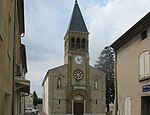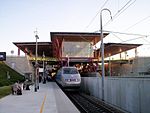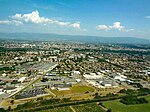Valence-Chabeuil Airport
Valence - Chabeuil Airport (IATA: VAF, ICAO: LFLU) is an airport in France, located about 5 miles (8 km) east of Valence (in the Drôme department, Rhone-Alpes region) and approximately 300 miles (483 km) south-southeast of Paris. The airport was a pre-World War II French Air Force (Armée de l'Air) airfield. After the Battle of France, it was seized by Nazi Germany in November 1942. It was later used by the Luftwaffe, and after the Allied Invasion of southern France in August 1944, by the United States Army Air Forces Twelfth Air Force. Used by the French Air Force base after the war, it was closed and today the airport is used for general aviation, with no commercial airline service. It is still occasionally used by military aircraft. The French army aviation (Aviation légère de l'Armée de terre) have maintained a small enclave here for many years operating a small number of diverse helicopter types as part of the test unit GALSTA/STAT. Closure of this facility (with the unit moving to Le Luc) was announced some years ago, but it would appear this has been rescinded.
Excerpt from the Wikipedia article Valence-Chabeuil Airport (License: CC BY-SA 3.0, Authors).Valence-Chabeuil Airport
Allée de l'Ancien Hippodrome, Valence
Geographical coordinates (GPS) Address Nearby Places Show on map
Geographical coordinates (GPS)
| Latitude | Longitude |
|---|---|
| N 44.915555555556 ° | E 4.9686111111111 ° |
Address
Allée de l'Ancien Hippodrome
26120 Valence
Auvergne-Rhône-Alpes, France
Open on Google Maps








